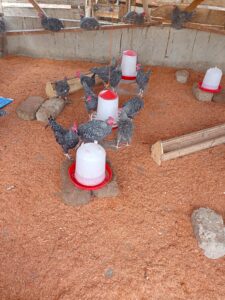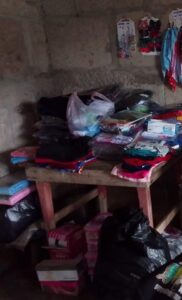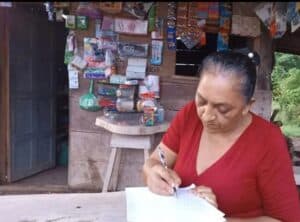Kojo: “We Need Tarpaulins to Dry Our Maize”
By Bernice Agyekwena – Communications Manager

Kojo is a Profile Farmer of the AED program by SHI
Kojo, a 66-year-old farmer and father of six children from Nyamebekyere obtained a higher yield this year on his maize farm by following the agronomic practices taught to Profile Farmers by the Agricultural and Entrepreneurial Development (AED) Program being implemented by Self Help International to equip rural farmers with best practices in agriculture.
However, he lost some of the yield because he had no access to a tarpaulin to dry and protect his produce from the heavy rains experienced in his community last year.
“I followed the teachings of the AED and planted the maize according to their specifications. When the maize was harvested, they assisted me with a tractor to cart my produce home. They also assisted me with a maize Sheller to shell my maize. However, the main problem was that the rains continued to fall and I could not dry my produce well because I did not have access to a tarpaulin. I lost some of my yield because they became moist as a result of exposure to rain; some of the maize got blackened and some even germinated.”
Kojo harvested six bags of maize from his farm which is about half an acre. This is in contrast to the three bags of maize he used to harvest from a one-acre farm using traditional farming practices.
“I am still happy with my yield and I have really benefited from being a Profile Farmer but I could have had more maize if I had a tarpaulin to dry my produce. In addition, if my plot had been up to an acre, I could have produced more maize”, he says.
Kojo is one of five Profile Farmers that were nurtured by the AED to serve as models for demonstrating the impact of modern agricultural technologies on crop yields. The farms of Profile Farmers are to serve as demonstration farms for other farmers. In addition, they are supposed to help other farmers adopt agricultural innovations through peer to peer learning.
To this end, Kojo says he has since been passing on the knowledge he has gained as a Profile Farmer to other farmers.
“I always follow the specifications of the AED and I am even teaching some of my fellow farmers to follow these rules. When I visit their farms and see that they broadcast their seeds instead of planting them in straight lines, I advise them on the benefits of planting maize seeds in straight lines and urge them to adopt it. I am currently coaching three farmers to adopt these best practices in agriculture.”
“I believe if more farmers adopt the teachings of the AED, my community will eventually prosper because it would lead to higher yields. It is my desire that more farmers in my community adopt and adhere to these farming practices.”

Some bags of maize harvested by Kojo
Giving his feedback on the new technologies he used on his farm, Kojo said there were occasions when the Hand Push Planter skipped some of the holes so certain planting spaces on his farm were not planted. Furthermore, some of the seeds were not virile since they failed to germinate.
He asked for a review of the routine application of fertilizer after 60 days since the height of the maize plants during that period makes fertilizer application cumbersome. He also asked for a review of the 70 cm by 30cm planting distance for the variety of maize to 70cm by 70cm to avoid the plants getting too close to each other and forming early canopy.
Kojo said transportation to and from their farms is a major problem. “If we farmers can be assisted to acquire a motor tricycle it will ease our transportation problems and also enable us to explore distant farmlands for crop cultivation.”
“The AED also needs to acquire more Hand Push Planters to prevent farmers from waiting long periods to use the planter,” he said.




